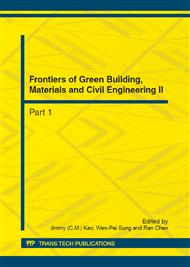p.1429
p.1436
p.1440
p.1444
p.1449
p.1454
p.1461
p.1465
p.1470
Experimental Study of Vegetation-Growing Concrete’s Resistance to Rain Erosion
Abstract:
Taking an experiment of vegetation-growing concrete’s resistance to rain erosion, the influence degree of the related factors on erosion amounts will be obtained. The erosion process of vegetation-growing concrete gunning slope is influenced by cement content, vegetation coverage, rainfall intensity and other factors. In this paper, it talks about the influence of different cement content, rain intensity and maintenance days on vegetation-growing concrete’s erosion. The results show that the anti-erosion ability of vegetation-growing concrete increases significantly with the increase of the cement content and the erosion amounts are linear with cement content. Based on the analysis to the interaction effects of the factors, some measures could be proposed for better usage of vegetation-growing concrete and its extension.
Info:
Periodical:
Pages:
1449-1453
Citation:
Online since:
August 2012
Authors:
Keywords:
Price:
Сopyright:
© 2012 Trans Tech Publications Ltd. All Rights Reserved
Share:
Citation:


